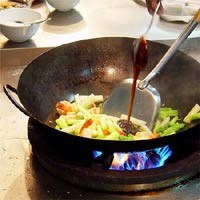Some of you might be a little mystified when looking at homes to buy or rent when the information states ‘European kitchen’, particularly if you are looking at recently built properties. Surely all houses and condos have such a kitchen, which we can safely assume means a modern kitchen with sink, drainer, cooker, worktops, cupboards and all other things that anyone might expect to find in a kitchen ‘back home’? However, a ‘modern kitchen’ is not what you would normally find in a traditional, and sometimes not so traditional, Thai home.
If you were to visit a Thai home in a rural area, or even one of the older type houses
in
the heart of Pattaya or Bangkok, more often than not you would find the
kitchen away from the house itself. It tends to be quite a simple space
which is open to the air and definitely without air conditioning! The
main feature is the ‘cooker’ although it is nothing like the cooker you
would have in your own kitchen: no knobs, no temperature control, no
oven, no extractor, no gas, no electricity….. Most of the cooking is
done using a charcoal pot which is placed under a circular opening in a
brick built stove upon which a wok is placed. A spare sack of charcoal
is always kept close to the cooking area so that if it runs out in the
middle of a cooking session, the cook can just grab another handful and
lob it onto the embers in the pot As the charcoal pot is the sole
source of heat used in a Thai kitchen you will appreciate that there is
no tradition of baked food in Thai cuisine.

|
Unlike
the traditional home baking of the west, which includes pies, cakes,
puddings and pastries, all Thai food is cooked on top of the heat
source, rather than in it. This means that all the food is cooked
quickly, which keeps in the flavours and natural goodness of the
dishes.
Rather than a fine array of kitchen units, a Thai kitchen only has
a couple of cupboards in which to store kitchen utensils, dry food,
herbs, spices, pastes and sauces such as nam pla (fish sauce), oyster
sauce, soy sauce and sweet chili dipping sauce. Needless to say, there
would be no fridge, so all the ingredients needed for a day’s cooking
are bought fresh from the market each morning. You may find water
filled saucers under the feet of any free standing cupboard, which is a
failsafe method of keeping the ants at bay, something that modern
kitchens generally fail to do.
Read more...





![A Tranquil Jungle House That Incorporates Japanese Ethos [Video]](https://asean2.ainewslabs.com/images/22/08/b-2ennetkmmnn_t.jpg)









